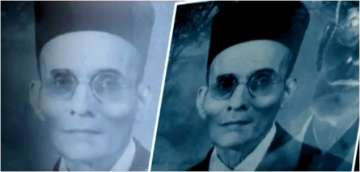The BJP has always been vocal about nationalist ideology and has praised the valour of freedom fighters and social reformers. The party recently proposed Veer Savarkar's name for Bharat Ratna. The Congress party along with other opposition parties hit out at the BJP-led government over its proposal to confer Bharat Ratna for the controversial freedom fighter Vinayak Damodar Savarkar.
Vinayak Damodar Savarkar, born on 28 May in a Brahmin family of Nasik, lost his parents at an early age. His older brother Ganesh Savarkar (Babarao) had a great influence on him. Apart from Ganesh, Narayan and Mainabai were the other siblings of Vinayak. He gained his nationalistic ideology from his brother and later became a revolutionary young man.
From his political groups to his 50 years in Andaman's Central Jail, here we tell you the lesser-known facts, contributions and controversies linked with Veer Savarkar:
Early days of Veer Savarkar
In his teenage, he formed a youth group and named it Mitra Mela. The aim of this group was to bring to the fore nationalistic and revolutionary ideas during the British era. As a teenager, he was inspired by politicians like Lala Lajpat Rai, Bal Gangadhar Tilak, and Bipin Chandra Pal. Vinayak Savarkar too part in Swadeshi Movement. During 1905 Dussehra celebrations, he burnt foreign goods in a bonfire.
He completed his Bachelors' Degree from Fergusson College' in Pune.
Veer Savarkar's days in London
Later, he received a scholarship offer from England to study law at Gray's Inn Law College. During his stay in London, he inspired his fellow Indian students residing with him at 'India House', and formed an organisation 'Free India Society' to fight against the British administration in India.
In Savarkar's book -- "The History of the War of Indian Independence", he has mentioned about guerrilla war, on the lines of '1857 Revolt', to attain Independence. However, the book was banned by the British government in India. But the book was published by Madame Bhikaji Cama in Netherlands, Germany and France. The book eventually found its way to Indian youth and inspired many to revolt against oppressive British government.
He also provided legal support to Madan Lal Dhingra, who was accused in the killing of a British Indian army officer named Sir William Hutt Curzon Wyllie.
Veer Savarkar's 50 years of imprisonment of Kala Pani
In 1909, his elder brother organised a protest against the 'Indian Council Act 1909' or Morle-Minto reform. VD Savarkar actively took part in the protest, which Britishers claimed to be a violent protest. Savarkar was charged for plotting armed revolt. He tried to escape but later was arrested by the police. He was sentenced 50 years of imprisonment, during which he was taken to Central Jail of Andaman and Nicobar, famously known as Kala Pani.
His years in the Cellular Jail, were very tough for him as he was severely tortured. Even then, he continued to propagate his nationalistic ideology and started teaching his fellow prisoners to read and write. He also took permission from the government to set up a library for prisoners in the prison.
Veer Savarkar's controversial book : Hindutva: Who is a Hindu?
During his imprisonment in, he wrote his famous and controversial book, Hindutva: Who is a Hindu? which was later published by his supporters. In this book, it was revealed that Savarkar was against orthodox Hindu belief and for him, Hindus are those who are a patriotic and proud inhabitant of 'Bharatvarsha' (India). In fact, Savarkar opposed the idea of cow worship. In his book, Savarkar wrote, "If Hindutva is to sustain itself on a cow's legs, it'll come crashing down at the slightest hint of a crisis."
In his book, he described Jainism, Buddhism, Sikhism, and Hinduism as one, who can support to create Akhand Bharat. The self-proclaimed atheist, Savarkar, was proud to be a Hindu and always described it as his political and cultural identity.
Veer Savarkar's life after imprisonment in Andaman's Central jail
After his release from Andaman jail on January 6, 1924, he participated in 'Ratnagiri Hindu Sabha', and work on the abolishment of untouchability and to preserve social and cultural heritage of Hindus. Dr Babasaheb Ambedkar compared his work with Lord Buddha.
In his other book, 'The Indian War of Independence'. In his book 'Kale Pani', he mentioned his struggle in cellular jail for Independence.
Savarkar had always been a fierce critic of the Indian National Congress (INC) and opposed the 'Quit India Movement'. He also objected to Congress's acceptance of Indian partition.
Veer Savarkar's death during hunger-strike
In 1964, Savarkar declared his wish to attain Samadhi at the age of 83, as he believed that his purpose of life was fulfilled after India gained Independence. On February 1, 1966, he started a voluntary hunger-strike which ended with his death on February 26, 1966.
ALSO READ | Publicly thrash those insulting Veer Savarkar: Uddhav Thackeray
ALSO READ | Shiv Sena demands Bharat Ratna for Veer Savarkar to ‘shut up Congress permanently’
WATCH | The life and true story of Veer Savarkar
